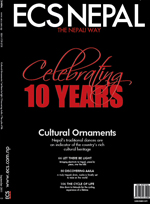Masks and Dances
ECS is ten years old. It is a great feeling to have and we must take a deep breath, celebrate, give a pat on the back to everyone who has made this possible, and then move on. There is so much of Nepal and in Nepal that we have not yet written about, photographed or talked about. It is going to take many more issues of ECS to cover our Sundar, Shanta, Bishaal Nepal. Issue after issue of ECS has tried to bring forth the various ways people look at, write about and discuss the many aspects of this country. Just when you feel you know or have heard enough of a particular place, people, festival, event…someone brings in a new angle. We all look forward to many more years for ECS.
 Every culture in the world gives a special place for masks and dances. Although we shall never know when or why masks were initially used or came into being, the basic reasons are usually quite obvious. People have many sides or attributes that they often keep “hidden” away and masks serve as a great way to bring them out in the form of art. These different characteristics of the same individual can be presented simultaneously by the clever use of different masks. While the basic two characteristics will be good and the bad, there are many shades of grey in between. Black and white are not the most colorful and our own nature and hence the colors of the masks cover the entire spectrum.
Every culture in the world gives a special place for masks and dances. Although we shall never know when or why masks were initially used or came into being, the basic reasons are usually quite obvious. People have many sides or attributes that they often keep “hidden” away and masks serve as a great way to bring them out in the form of art. These different characteristics of the same individual can be presented simultaneously by the clever use of different masks. While the basic two characteristics will be good and the bad, there are many shades of grey in between. Black and white are not the most colorful and our own nature and hence the colors of the masks cover the entire spectrum.
The dances performed with masks then help further clarify the true character of the individual being portrayed. Body language, in the form of various moves in dances, is probably the biggest “give away” when it comes to understanding people. Add to this the appropriate music and the whole context of our being becomes quite obvious to the viewer. Imagine watching a horror movie with the “mute” button on or what would be the response of the audience if the same music was played when the hero or the villain entered the stage. Music makes a big difference. Historically many Nepali communities have perfected the masks, dances and the music to tell “their stories” over and over again. Masks and dances are an integral part of Nepal’s intangible heritage.
In this anniversary issue of ECS, we have brought you stories and images of various aspects of Nepal, the people, and places. Special coverage has been given to the amazing crafts persons ranging from stone and clay to wood craft. Do take time out to visit these skillful artists. We take you to exotic locations like the caves around Kathmandu valley. We also have a special section dedicated to the guru or teacher who always has a very special place in Nepali society. Enjoy this tenth anniversary issue and send us your ideas and suggestions about what we can cover in the next ten. Whatever you are planning on doing in the coming month, please make sure you take some time out for the Nepali way.






